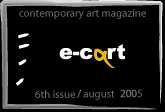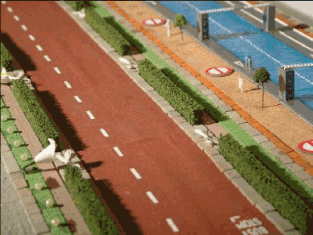| |
|
||||||||||||||||
| |
 |
 |
|
||||||||||||||
 |
|
 |
|
||||||||||||||
 |
|
||||||||||||||||
 |
|
||||||||||||||||
 |
 |
|
|
||||||||||||||
| |
 |
 |
|
||||||||||||||
 |
 |
|
|
||||||||||||||
| |
 |
|
 |
|
|
|
|
|
|||||||||
| |
|
||||||||||||||||
| |
|
||||||||||||||||
 |
|
||||||||||||||||
 |
|
||||||||||||||||
 |
|
||||||||||||||||
 |
|
||||||||||||||||
 |
 |
|
|||||||||||||||
| |
|
|
|
|
|
|
|
|
|
|
|
|
|
|
|
|
|
Simona Nastac: The Unrealised Projects Archive collects submitted project proposals from artists, designers, curators and writers, which are - as you say on the website of the project (www.unrealisedprojects.org) - "unrecognised", "unfinished", "and unfulfilled" or which remain "unwritten". What is the goal of the project and how it operates?
Sam Ely & Lynn Harris: One of our main interests in starting the project came from a desire to have an ongoing 'conversation' about potentiality in making, highlighting the moments when the work is being made, versus the more tangible, finite and marketable product. We're also interested in how, in a world of hyper achievement, qualitative comments of success and failure usually ape recognition of this process and how the reading of a (visual) work is an active and personally engaging form of communication.
So, one of our goals with the project is to highlight these moments of production for both the artist and the audience. For the artist, loads of good ideas never see the light of day for so many reasons. This project allows those good ideas a public viewing, a platform for ideas which have not found placement otherwise (some of these ideas are not attached to desires to make a successful piece of artwork, but remain streams of consciousness, whimsies, or epiphanies - things that, when put together strategically, make a successful and finished work).
As an audience member reading through the projects, a different kind of criticality is employed than when looking at a finite and finished work, a criticality that is driven by imaging a potential outcome instead of responding to specific expectations for a work. In this state, the viewer is personally engaged and does, in fact, become a type of co-author through the nature of the building of meaning in the mind that is characteristic of reading. Most importantly, by the nature of the unrealised, these ideas are not fixed allowing the audience to intellectually actualise an outcome. The reader is essentially finishing off the work, whether that's just in placing it in the mind's eye or making decisions whether it could or should be realised. We seem to desire closure, answers, endings. This desire is built through potentiality and this lingering sense of potentiality is where the audiences' curiosities, imaginations and need for closure can be fulfilled.
S.N.: Apparently, there is no hierarchy in the archive between "unrecognised", "unfinished" and "unfulfilled". However, there is certainly a distinction. "Unrecognised" implies, inherently, a failure. "Unfinished" could mean both in progress or abandoned. And "unfulfilled" presuppose the existence of an idea, but not necessarily the intention to transfer it into practice, to make it visible. Why is it important to acknowledge all the projects as having an equal significance?
S.E. & L.H.: These variations represent the various ways in which different individuals will interpret, consume, market, and make work. Our intention was to create a fairly generic structure that could be used by anyone, but still remain bound within a specific context.
S.N.: One of the main concerns of your initiative seems to be the idea of failure. Valorising the failure involves, necessarily, an attempt to relativize the notion of 'success'. But both can be defined as such only in relation with a certain context, so that the attempt to distinguish between them becomes almost redundant. What is your understanding of failure? Within the context, could the archive be seen as a mean of critique to the address of social or institutional working concepts such as "power" and "prestige"?
S.E. & L.H.: Absolutely. The categorisations of success and failure are terms that are terminally bound to one another for meaning and reference and have no relevance outside of momentary and specifically regulated judgement. And while we have not set out to focus on failure, the implication is inherently bound up with the idea of the unrealised. We're trying to create a space where, through the reading of each work, these qualitative statements are not necessary to access the work. Through the nature of reading and of the open-ended nature of the project, an audience member will immediately find ways to visualise those projects that interest them. How do you read a story without picturing the characters and scenes? At that point, the question of a project's failure or success is not being asked, this reflective state is being replaced by the activation of the work. In some ways, the use of this open submission archive is a reaction to the market and authoritarian/arbitrary influences that determine the relevance of a work or a body of works which often demean the relevance of alternative influences on that market. And as artists, who are not officially backed by one gallery, we have created our own network of artists/curator/designer/curator to work with, promote and be promoted by. As is common these days, we have bypassed the institution and remain working through this shared network.
S.N.: To a certain degree, the archive seems to me to have a paradoxical dimension. Once the ideas or the projects become visible through the Unrealised Projects' website, they reach to a certain achievement, which alters their definition as such. How do you keep the balance between "unrecognised", "unwritten" etc. and their (re)presentation?
S.E. & L.H.: The whole project is interpretable. The projects have technically been realised once consigned to text, but some would say that even speaking about these ideas would be considered a realisation. So we're left with a debatable, philosophical enquiry into ideas raised by the proposition of the unrealised. We like that. To begin and end with questions. It means that the participants and the audience must take responsibility for their own interpretation, we do not pre-suppose a finite, ideological conclusion.
S.N.: If withdrawal can be a creative act, I would like to let this interview unfinished.
S.E. & L.H.: We would like to go by asking any readers if they are interested in participating in Unrealised Projects Volume 3. Please contact us if you are. The deadline is ongoing